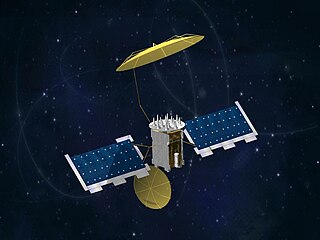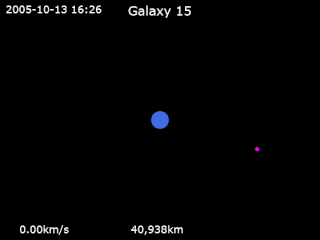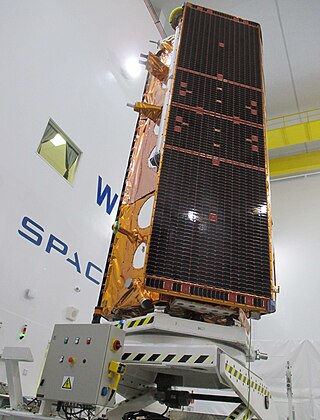Overview
The satellite belongs to Hisdesat (Spanish company participated by Hispasat (43%), Ingeniería y Servicios Aeroespaciales (30%), Airbus (15%), Indra Espacio (7%) and Sener (5%)), and its initial investment was 415 million euros. It was built by Space Systems Loral in California United States, with an expected useful life of at least 15 years. Its takeoff mass was about 3,700 kilograms. It is instrumented with several transponders in the X band and one in the K military band. It is situated on a geostationary orbit at 36,000 kilometres of altitude, 30 degrees west, over the Atlantic Ocean.
The satellite provides coverage to humanitarian, security and intelligence missions as well as to military operations, image transfers, embassy services and Spanish governmental communications.

A communications satellite is an artificial satellite that relays and amplifies radio telecommunication signals via a transponder; it creates a communication channel between a source transmitter and a receiver at different locations on Earth. Communications satellites are used for television, telephone, radio, internet, and military applications. Many communications satellites are in geostationary orbit 22,300 miles (35,900 km) above the equator, so that the satellite appears stationary at the same point in the sky; therefore the satellite dish antennas of ground stations can be aimed permanently at that spot and do not have to move to track the satellite. Others form satellite constellations in low Earth orbit, where antennas on the ground have to follow the position of the satellites and switch between satellites frequently.

The Guiana Space Centre, also called Europe's Spaceport, is a European spaceport to the northwest of Kourou in French Guiana, a region of France in South America. Kourou is located approximately 310 mi (500 km) north of the equator at a latitude of 5°. In operation since 1968, it is a suitable location for a spaceport because of its equatorial location and open sea to the east.

Skynet is a family of military communications satellites, now operated by Airbus Defence and Space on behalf of the United Kingdom's Ministry of Defence (MoD). They provide strategic and tactical communication services to the branches of the British Armed Forces, the British intelligence agencies, some UK government departments and agencies, and to allied governments. Since 2015 when Skynet coverage was extended eastward, and in conjunction with an Anik G1 satellite module over America, Skynet offers near global coverage.

The Indian National Satellite SystemINSAT, is a series of multipurpose geostationary satellites launched by ISRO to satisfy telecommunications, broadcasting, meteorology, and search and rescue operations. Commissioned in 1983, INSAT is the largest domestic communication system in the Indo-Pacific Region. It is a joint venture of the Department of Space, Department of Telecommunications, India Meteorological Department, All India Radio and Doordarshan. The overall coordination and management of INSAT system rests with the Secretary-level INSAT Coordination Committee.

A military satellite is an artificial satellite used for a military purpose. The most common missions are intelligence gathering, navigation and military communications.

The Mobile User Objective System (MUOS) is a United States Space Force narrowband military communications satellite system that supports a worldwide, multi-service population of users in the ultra high frequency (UHF) band. The system provides increased communications capabilities to newer, smaller terminals while still supporting interoperability with legacy terminals. MUOS is designed to support users who require greater mobility, higher bit rates and improved operational availability. The MUOS was declared fully operational for use in 2019.
Hispasat is the operating company for a number of Spanish communications satellites that cover the Americas, Europe and North Africa from orbital positions 30.0° West and 61.0° West. It was formed in 1989 and its activities include provision of communication services in the commercial and government sectors. Hispasat's fleet of satellites broadcast more than 1250 television channels and radio stations to more than 30 million homes, as well as providing services such as broadband to mobile telephones and landlines.

SES S.A. is a Luxembourgish satellite telecommunications network provider supplying video and data connectivity worldwide to broadcasters, content and internet service providers, mobile and fixed network operators, governments and institutions.

AMOS is a series of Israeli communications satellites operated by Israel-based Spacecom. All AMOS satellites were developed by Israel Aerospace Industries (IAI) using the AMOS bus satellite bus, except for AMOS-5 which was developed by ISS Reshetnev using the Ekspress bus satellite bus, and AMOS-17 which was developed by Boeing on its BSS-702.

The Arab Satellite Communications Organization is a communications satellite operator in the Arab World, headquartered in the city of Riyadh, Saudi Arabia. Arabsat was created to deliver satellite-based, public and private telecommunications services to the Arab States, in accordance with International Standards. With 21 member countries, the organization plays a vital role of enhancing communications in the Arab World.
XTAR, LLC is a commercial satellite operator exclusively providing services in the X band frequency range, which is the communications cornerstone of today's military, diplomatic, humanitarian and emergency disaster response operations. A privately owned and operated company, XTAR supports the critical satellite communications needs of governments around the world through its two X-band payloads. The XTAR satellites were designed and built by private financing. Loral Space & Communications, Inc. owns the majority share. XTAR is headquartered in Ashburn, VA.

Satmex was a company set up in Mexico in the mid-1990s through 2014 that operated space communication satellites that provide services to the Americas.

Galaxy 15 is an American telecommunications satellite which is owned by Intelsat. It was launched for and originally operated by PanAmSat, and was subsequently transferred to Intelsat when the two companies merged in 2006. It was originally positioned in geostationary orbit at a longitude of 133° West, from where it was used to provide communication services to North America.
Airbus Defence and Space is the division of Airbus SE responsible for the development and manufacturing of the corporation's defence and space products, while also providing related services. The division was formed in January 2014 during the corporate restructuring of European Aeronautic Defence and Space (EADS), and comprises the former Airbus Military, Astrium and Cassidian divisions. It is the world's second-largest space company after Boeing and one of the top ten defence companies in the world.
The Mexican Satellite System, also known as MEXSAT, is a network of three satellites bought by the Mexican government's Ministry of Communications and Transportation. The three satellites are named Mexsat-1, Mexsat-2, and Mexsat-3. Subsequently, they have also been named Centenario, Morelos III and Bicentenario respectively.
Hisdesat is a Spanish company created in 2001 by Hispasat (43%), Ingeniería y Servicios Aeroespaciales (30%), EADS CASA, Indra Sistemas (7%) and SENER (5%) with initial investment of 415 million euros.

Paz is a Spanish Earth observation and reconnaissance satellite launched on 22 February 2018. It is Spain's first spy satellite. The satellite is operated by Hisdesat. Paz was previously referred to as SEOSAR.
Spainsat NG is a Spanish communications satellite program aimed at developing next-generation satellites to meet Spain's government and military secure communications needs.
Eutelsat Quantum is a communications satellite developed in the framework of a public-private partnership between the European Space Agency, Eutelsat and Airbus Defence and Space. Operated by Eutelsat, its design allows for it to reconfigure its radios coverage zone and alter its performance according its needs. It is located in a geostationary orbit and its longitude may be modified to cover any region in the world.












